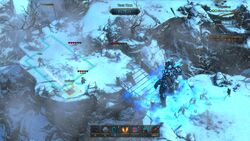RPG Codex Review: ADOM
RPG Codex Review: ADOM
Review - posted by Crooked Bee on Wed 18 February 2015, 01:00:18
Tags: Ancient Domains of MysteryRare are the times that the Codex's front page braves the dark and fearsome world of roguelikes. Being predominantly a traditional RPG, not roguelike-focused website, permadeath scares us - all of us except the courageous Deuce Traveler, who in this review ventures headlong into ADOM from the perspective not of a roguelike expert, but a fellow veteran RPG player. One of us, then! Let's hear what he has to say.
For the details leading up to this conclusion, be sure to read the full review.
So, would I recommend Ancient Domains of Mystery?
Well, I highly recommend that every Codexer play the game once, but I don't recommend that you attempt to actually beat it. I know that seems like a contradiction, but while ADOM is a treat for those who enjoy RPG design, it loses its charm as a game and begins to feel like work after your 20th or so character death. I suggest playing the game for a few hours without backing up save states or looking at the ADOM wiki. Then, when you begin to feel frustrated with the experience, go ahead and look at the wiki for dungeon locations and to get a general idea of where you should explore next. If you still find yourself feeling frustrated after that, leave the game and go find something else to play that is more enjoyable. But if you feel driven to beat the game and are still enjoying yourself, then you'll be able to spend the next few months or even years defeating it. Good luck, and don't get eaten by a grue.
Well, I highly recommend that every Codexer play the game once, but I don't recommend that you attempt to actually beat it. I know that seems like a contradiction, but while ADOM is a treat for those who enjoy RPG design, it loses its charm as a game and begins to feel like work after your 20th or so character death. I suggest playing the game for a few hours without backing up save states or looking at the ADOM wiki. Then, when you begin to feel frustrated with the experience, go ahead and look at the wiki for dungeon locations and to get a general idea of where you should explore next. If you still find yourself feeling frustrated after that, leave the game and go find something else to play that is more enjoyable. But if you feel driven to beat the game and are still enjoying yourself, then you'll be able to spend the next few months or even years defeating it. Good luck, and don't get eaten by a grue.
For the details leading up to this conclusion, be sure to read the full review.
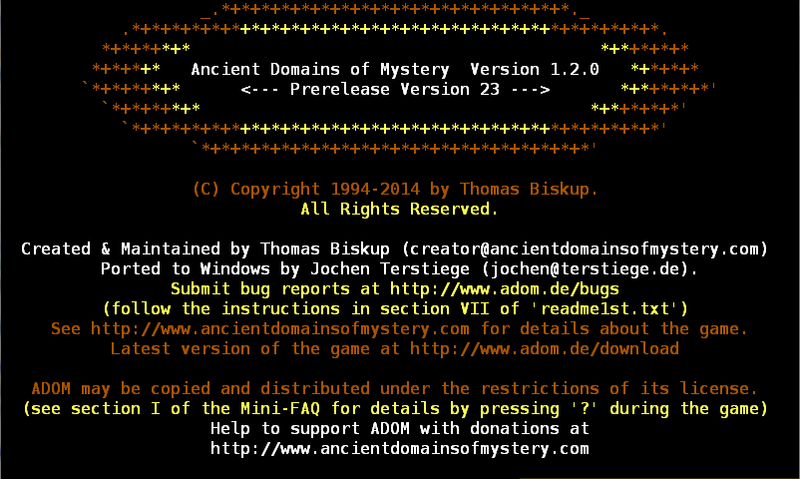
[Review by Deuce Traveler]
Ancient Domains of Mystery (or ADOM) is a roguelike first released in 1994 by computer programmer Thomas Biskup. It has a well-deserved reputation for being overly difficult, even by the hefty standards of its roguelike peers. For this review, I played two versions of the game: an early DOS version that uses ASCII characters for visual depictions of terrain and characters, and the publicly released version 1.2.0 that has more content and static paperdoll graphics.
Character Creation
At the beginning of character creation, you are first assigned a random birth sign (called a star sign), each of which benefits certain classes and play styles. For instance, the Wand sign increases starting mana, which benefits spellcasters, while the Dragon sign adds to Toughness and Strength, which benefits Fighters. This twist to standard character creation is well implemented, as it encourages you to step out of your comfort zone and create characters that you might not have been considering before.
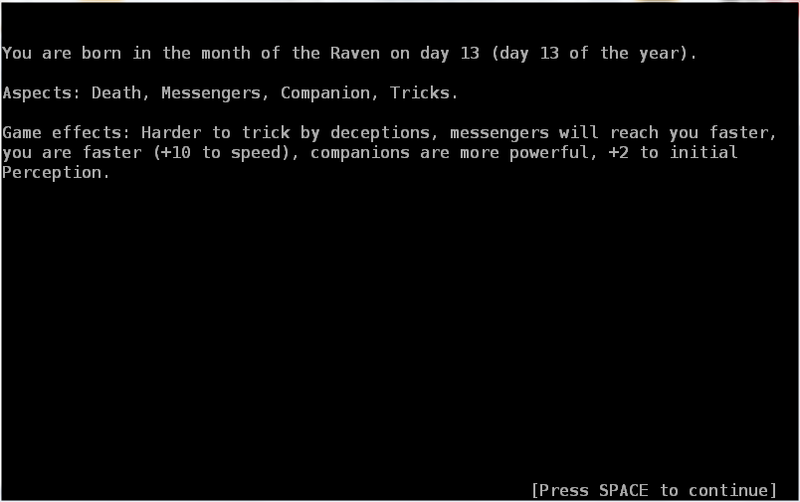
Character creation offers a large number of options to the player, with 10 character races to choose from and 20 different character classes. The four core classes from Dungeons & Dragons - Thief, Fighter, Wizard and Cleric - are here, along with familiar variants such as the Paladin and Assassin. However, there are also some odd classes that are particular to ADOM, such as the Merchant who gets better deals when buying and selling in shops, and the Farmer who is better at picking herbs and planting crops. Some race-class combinations make obvious sense, such as the orc-barbarian or the high elf-wizard. Other combinations aren't as logical, but are fun to slap together anyway for the mental image, such as a ratling-monk or troll-bard.
Characters in ADOM have nine main attributes, which are determined by race, class and other factors: Strength, Learning, Willpower, Dexterity, Toughness, Charisma, Appearance, Mana and Perception. Strength, Dexterity, Perception, Willpower, Toughness, Appearance and Charisma should be familiar enough to most gamers used to D20 and D6 RPG systems. Learning affects how fast characters improve their starting skills, based on race and class. Mana is important for characters with pets or summoned creatures, and is mostly useless for other classes. Characters also have an alignment, which is determined primarily by race, and sometimes also affected by class and star sign. Finally, the player gets to choose starting talents for his character, which can offer various minor bonuses. For example, a bonus to magic damage inflicted, to hit point recovery speed, to melee attack accuracy and so on. After that, it's onto the game proper.
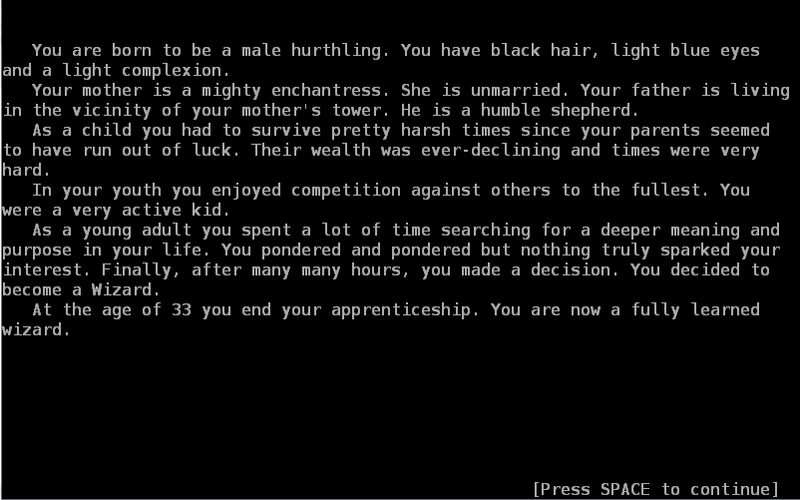
Plot
The game's basic plot is fairly simple. The land you find yourself in was once peaceful, but now there are reports of abominations and chaotic magic issuing forth from various dungeons, killing or mutating those in the vicinity. It is believed that if the spread of this threat is not halted, then the kingdoms of the world will be completely overrun. Many heroes have stepped forth in an attempt to stem this dark tide. It's quite appropriate that ADOM's story emphasizes that many heroes have volunteered to fight, because you will die and have to start over again more times than you'll be able to count.
Your character's alignment will affect how the story progresses. Lawful and neutral characters follow the typical path of a hero: slaying followers of the chaos gods and evil bandits in order to keep the civilian populations safe and warm in their abodes. Chaotic characters can fall into a completely different path, supporting the followers of chaos and ultimately becoming a servant to their evil cause. Some quest-lines allow you to choose between lawful or chaotic paths, each granting different rewards.
You can perform immoral actions, which will shift your alignment towards chaos. This is one thing that bothered me a bit about ADOM. Supporters of chaos are synonymous with evil in this game, which doesn't always make sense. Yes, an evil cleric of a chaos god would support the forces of chaos, but why should an evil bandit? If the forces of chaos win, the game indicates that civilization collapses and the population is wiped out. Shouldn't the forces of evil join with the forces of good against chaos in order to maintain their existence? I suppose I'm thinking too deeply into this, but it didn't make much sense when one of my lawful characters switched to the side of world-destroying chaos simply because he spent a couple of days gambling in the in-game casino. Yes, in this game even playing the slot machines will change your alignment.
Your character's final alignment will determine what endings are available to him. As one might expect, siding with the forces of chaos in order to destroy the kingdom will result in an ending much different from that of the typical lawful character attempting to seal the portal of chaos. But the game has a wide variety of endings, not only dependent upon the choices you make, but also on how badly the powers of chaos affected your character during his adventure.
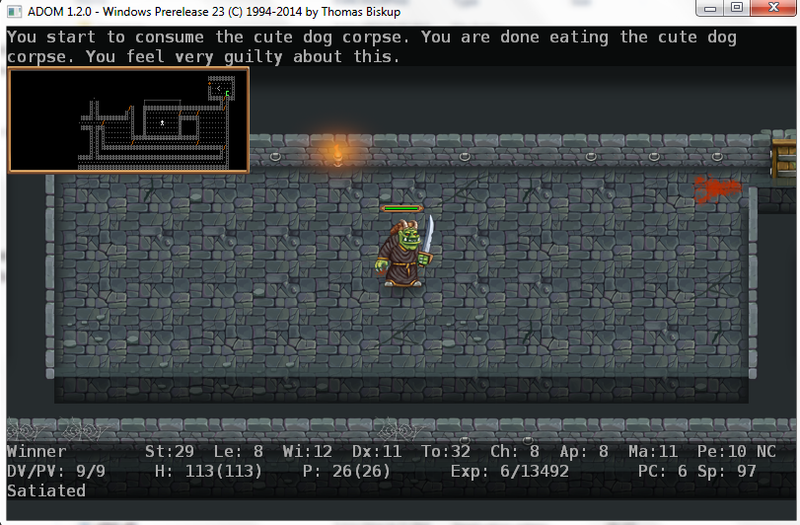
Gameplay
I could probably write a short book about ADOM's character creation and gameplay, so I'll focus on the highlights. First, there are countless ways you can manipulate objects in this game, from pulling levers to using a pick-axe to dig a tunnel towards an objective. Any object you can pick up can be loaded into a missile weapon slot and thrown at an enemy, or placed in your character's hand to be wielded as a clumsy weapon. That might seem like a useless feature at first, until you realize that, for instance, a potion of confusion can be thrown at or smashed upon an enemy, with appropriate results. Some objects can be kicked and destroyed, while monks can kick in order to do extra damage to a foe or even demolish walls. Frost bolts can be used to create weak bridges of ice, while flame bolts can melt those same bridges. Herbs can be picked, seeds planted, equipment repaired, and items created, as long as your character has the skills and resources to do so.
Each character has a god that can be worshipped, which is determined by his alignment. This is helpful when you come across an altar of that god. The character can sacrifice items desired by his god on the altar and then pray for support, which can come in the form of healing or even magical artifacts. By sacrificing items, your character increases his Piety score, which reflects how pleased his god is with him. You can also make sacrifices at altars of other gods, which will shift your character's alignment towards the alignment of the god he is trying to please. Sometimes killing the wrong creature can also cause a shift in alignment. For example, at one point in my playthrough, it seemed like blink dogs were trying to kill my character, which caused unwanted alignment shifts when I defended myself.
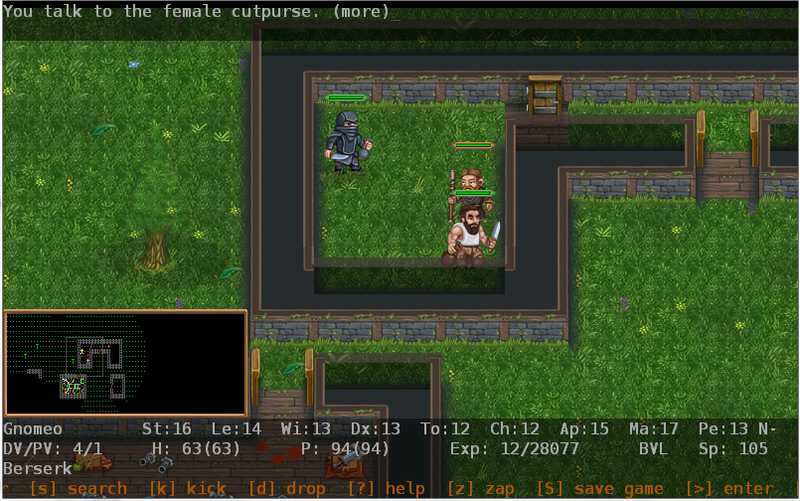
Throughout the world of ADOM you will discover pools, which along with certain items, can imbue your character with special properties called intrinsics. By wearing the right items or drinking from the right pool, a character can gain resistances to things like cold, fire, electricity and so on. If a character is really lucky when drinking from a pool, they might have the 'doomed' status effect removed, be granted a Wish, or even gain permanent Invisibility. However, I found drinking from pools to be harmful more often than it was helpful. Some of the worst outcomes of drinking from a pool include becoming 'doomed', becoming cursed, or gaining the Teleportitis intrinsic. Teleportitis causes a character to randomly teleport to a new location every so often when exploring a dungeon. This condition is both permanent and unpredictable. You might be teleported directly into a crowd of deadly enemies just as your character is trying to hole up and heal. Teleportitis was very helpful to me in the last levels of the final dungeon though, as it allowed my gnome elementalist to effectively snipe a large number of earth grues that could walk through walls and kept attempting to trap him in a corner.
Although the average dungeon level in ADOM is rather small compared to some other roguelikes, they are still very dangerous, with high rates of monsters repopulation. There are cavernous rooms with few corridors to hide in, levels partially flooded with water that has to be somehow crossed without falling, monster-filled treasure vaults, and rooms that for some reason are filled with a variety of hit point draining, equipment destroying traps. This last type of room is the most frustrating, unless you are playing a class that can detect such traps before accidentally falling into one. Some dungeons levels are randomly generated from game to game, while others like Dwarftown are predetermined.
You can instantly identify the basic properties of a piece of equipment by simply wearing it, though this can backfire if it ends up being cursed. While cursed consumables such as potions and scrolls are normally purely negative, cursed equipment can actually have beneficial effects. The real problem with cursed equipment is that it's impossible to remove until a remove curse spell is cast upon the character. This is in contrast to most other roguelikes where cursed equipment typically has negative effects while still being hard to remove. Mark this as one of the few aspects in which ADOM is easier on the player than its counterparts.
Combat in ADOM is a simple turn-based affair. You can throw or fire a ranged weapon at any enemy in sight, or walk your character into the enemy character in order to strike in melee. A small health bar at the bottom of each character's paperdoll shows how many hit points remain for each. For magic, characters have Power Points, which fuel spell use. When you reach zero power points, you can't cast spells until you regenerate enough points to fire off another one. When you reach zero hit points you die, your character data files are erased, and you get to start all over again at character creation. In terms of survival, there is no perfect character class. Though some are clearly better than others, each one has significant vulnerabilities that will eventually be exploited by the game.
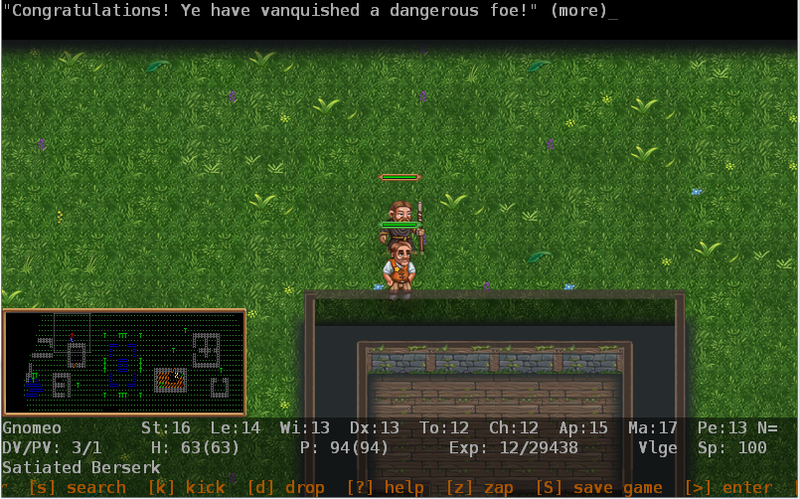
For melee fighters, monster encounters are quite deadly at the beginning of the game, due to the status effects they can inflict. Many creatures have attacks that result in attribute loss, which can be devastating if your fighter continuously has his strength drained. If you decide to tough out the game with a melee character, you also have to beware of the paralysis effect inflicted by enemies like ghuls and gelatinous cubes. All it takes is one paralyzing strike and you're pretty much dead, watching helplessly as your character's hit points dwindle down to zero.
Well, that sounds bad, you think. So now you decide to build a ranged character. The problem with that is that while ranged characters are great at shooting enemies at range, they can easily become surrounded, due to incorporeal foes that pass through walls, or ambush rooms with disappearing walls set up in a way to ensure your character is jumped from all sides. And heaven help you if you are down in the lower levels of a dungeon when you suddenly run out of ammunition and the materials required to resupply yourself.
All right, so it sounds like a spellcaster is the way to go then. But spellcasters have their own very severe limitations. First, casters usually have lower hit points and horrible fighting abilities. Second, they learn magic through the use of spellbooks, and each spell learned has a limited number of uses before fading from memory, requiring the spellcaster to reread the book to cast it again. So now you have to carry your spellbooks around with you to occasionally recharge your spells, rendering your spellbooks vulnerable to fire attacks and water traps. But even if you find a way to preserve your spellbooks, they disappear from your inventory after a small number of uses. This game has a lot of ways it likes to screw with you.
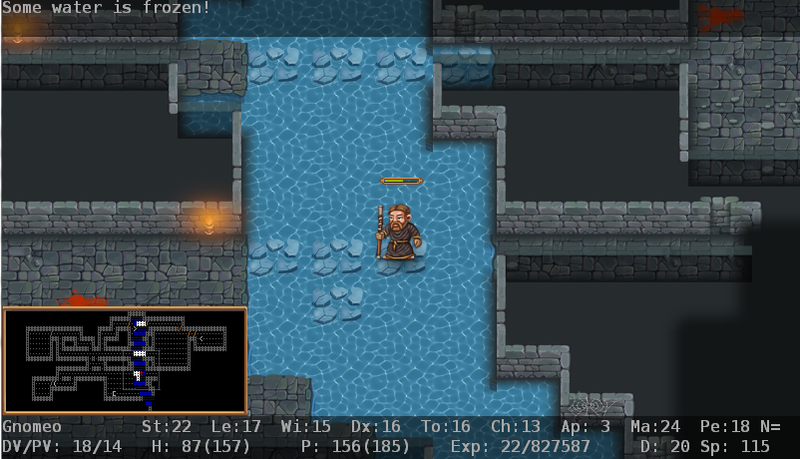
Want to take your time and explore every area of the game? Well, you can't at first because hunger is a huge issue, especially on the overland map, and a day's worth of food is both expensive and somehow weighs half the weight of heavy armor. Also, the land is suffering from chaos radiation and your character will start mutating as the game progresses. Even beneficial mutations can have huge downsides. For example, a permanent fear effect that scares away enemies, but also results in merchants calling the guards on you when you go near their shops to try and buy food. Another mutation creates an extra gibbering mouth on your character that will occasionally cast some sort of cryptic spell effect, draining you of all your spellcasting power points in the process.
Often the game's internal logic makes no sense. For example, entering a certain tower of flame causes all of your non-fire resistant items to quickly burn away. However, enemies that you kill there drop items that should have long burned away as well, and which they promptly do shortly after you pick them up. And in that same flaming tower, you can cast cold spells, but in a certain land of ice and snow you are prevented from using fire effects. And then there's those creatures that make you unlucky or 'doomed' if they attack you and you strike back at them, but whose corpses remove the status if you eat them(!).
So you take copious notes, with untold numbers of characters to dying in the process of exploration, and now you are finally ready to make a speed run through the main quest areas while avoiding unnecessary risks, in order to beat the game. Well, you're still quite likely to see your high level character killed. My most successful characters were killed due to undead spirits surprising me by walking through walls and aging them to death with a series of successful attacks. There doesn't seem to be as large of a variation of enemies in ADOM as in other roguelikes. Instead, the monsters scale with the dungeon level, so my high-level character can easily take out a ghul on the first level of a dungeon, but a ghul on level 40 is likely to paralyze him on the first hit and easily finish him off from there. Once I had a character with the 'doomed' status walking in a dark area and I received a message telling me I should worry about being eaten by a grue. "What a nice hearken back to the old Zork games", I thought with a smile, shortly before taking a couple more steps and receiving an instant death, wiping out my 30th level character. The game starts out as quite a fun experience, but transitions into feeling like work as you try to grind out a character strong enough to finish the game without dying a stupid death and watching hours upon hours of labor get wiped out. Other roguelikes made me feel like each death was the result of my own stupidity. This is the first roguelike I've played in which I felt like the game was trolling me.
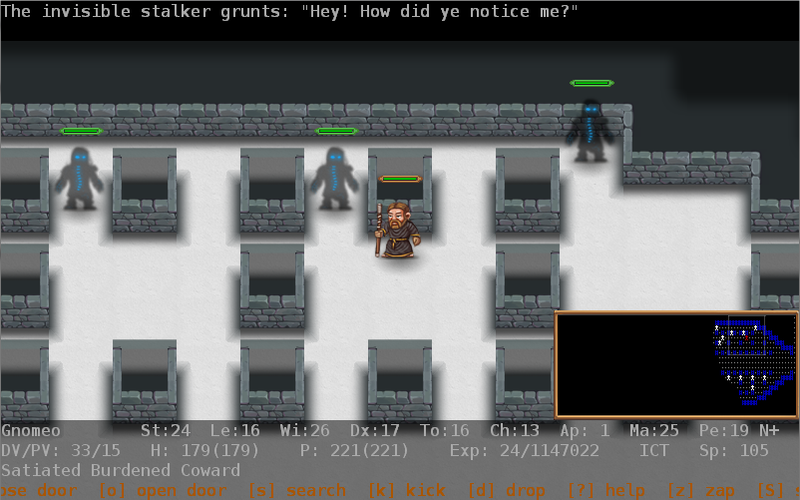
And if the game's logic doesn't drive you batty, the user interface just might. There are usually a large number of keys one has to learn in order to play a roguelike, but ADOM's key bindings are truly nonsensical. Some keys are easy to remember, such as 'k' for kick and 'x' for a readout on experience points. But others are a confusing mess, such as 't', which is used both for throwing a weapon or firing a bow. Other times there are a combination of keys that have to be pressed for certain results. Even after spending over a hundred hours playing, I found myself still referencing the in-game manual in an attempt to figure out how to properly interact with the game. I never had this much trouble in other roguelikes, so I'm hazarding a guess that when this game was translated from German language keyboards to English ones, the translation didn't go smoothly.
Continual Support
As mentioned previously, ADOM has gone through numerous changes over the years. The game started out in ASCII with an '@' sign representing the player, then transitioned to more colorful tilesets that retained the letter-based characters and monsters, but supplemented the game with better floor tiles to simulate dungeon, town or outdoor environments. The current version uses the paperdoll models that I mentioned earlier in this review, but also features some animations, which range from merely workable to quite good. For example, the fireball spell effect simply changes all the affected tiles around the character to red and isn't otherwise impressive. In contrast, the lightning bolt effect actually looks like lightning arcing towards its intended target. Sound effects can also be considered merely workable in the game's newer versions, and there's also background music which I felt was enjoyable and of decent quality.
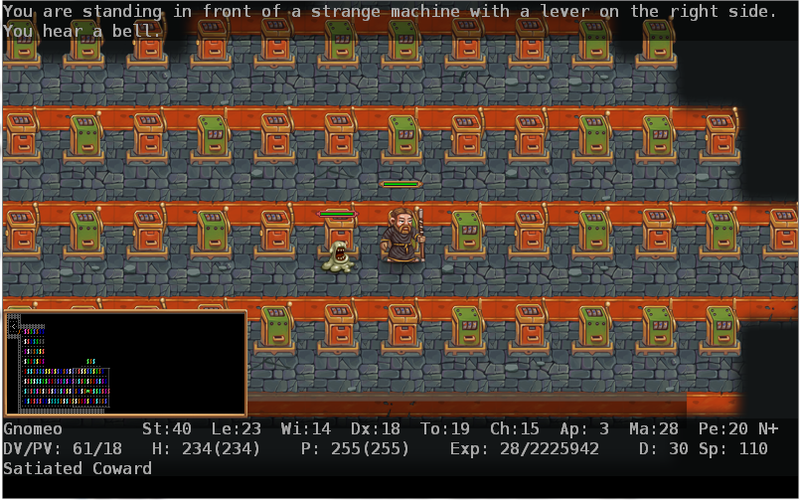
New dungeons and quests have also been added to ADOM over the years. For example, an older DOS version of the game didn't have the easy starter dungeon for beginners, while the last publicly released version for Windows did. For those who love this game and want to financially support its creator, ADOM Deluxe is currently in development and scheduled for release on Steam. It will include additional games, new quests and artifacts, extended character generation options, and the ability to save and load characters (possibly eliminating the constant fear of permadeath).
There is a website called Alucard's server, which allows players to play the game online. The only real advantage to this is that games played on the server can be viewed by others. So when a certain famous RPG designer finishes embarrassing himself playing Arcanum, we'll have something else for him to try.
There is also an ADOM II in development, which used something called JADE (Java-based Ancient Domains Engine). The original vision for this game was quite grandiose, with a randomly generated fantasy world that was supposed to be created for each new game. This land would progress through time, with a dynamically shifting chain of events for the hero to wade through. Imagine a procedurally generated world where human towns would be dynamically raided by nearby orc tribes, and quests would be dynamically generated for the hero to rescue hostages retrieve artifacts. ADOM II is still in a primitive state but a version of it is available for download. Mr. Biskup also offers access to the private development releases of ADOM II, for the price of eight euros.
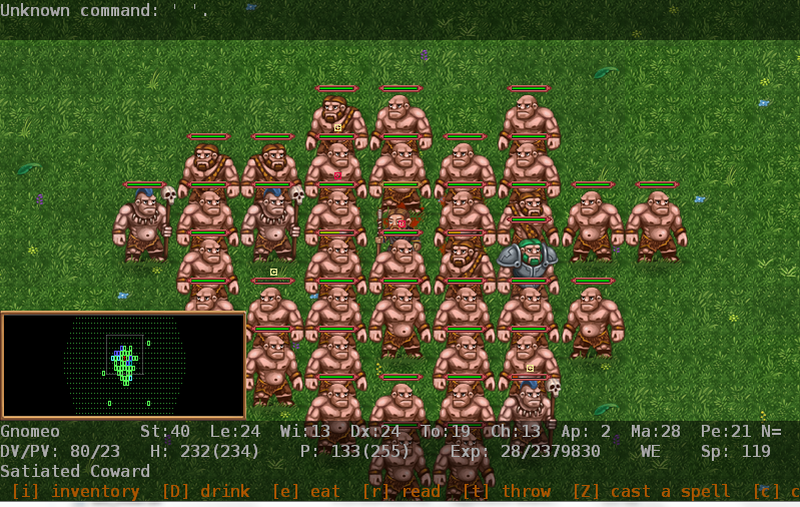
Conclusion
So, would I recommend Ancient Domains of Mystery? Well, I highly recommend that every Codexer play the game once, but I don't recommend that you attempt to actually beat it. I know that seems like a contradiction, but while ADOM is a treat for those who enjoy RPG design, it loses its charm as a game and begins to feel like work after your 20th or so character death. I suggest playing the game for a few hours without backing up save states or looking at the ADOM wiki. Then, when you begin to feel frustrated with the experience, go ahead and look at the wiki for dungeon locations and to get a general idea of where you should explore next. If you still find yourself feeling frustrated after that, leave the game and go find something else to play that is more enjoyable. But if you feel driven to beat the game and are still enjoying yourself, then you'll be able to spend the next few months or even years defeating it. Good luck, and don't get eaten by a grue.
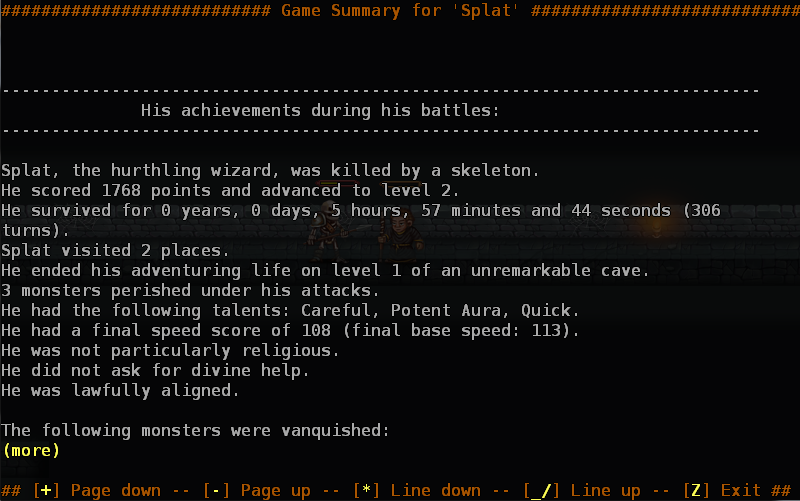
For more information on ADOM, visit the official website: http://adom.de/











